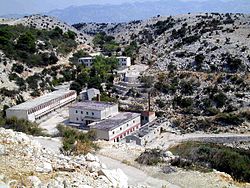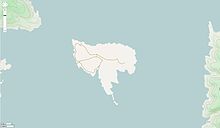Goli Otok


Goli otok (pronounced [ɡôliː ǒtok]; meaning "barren island", literally: "naked island"; Template:Lang-it) is a barren, uninhabited island that was the site of a political prison in use when Croatia was part of Yugoslavia. The prison was in operation between 1949 and 1989. The island is located in the northern Adriatic Sea just off the coast of Primorje-Gorski Kotar County, Croatia with an area of approximately 4 square kilometers (1.54 square miles).
Goli otok prison
Despite having long been an occasional grazing ground for local shepherds' flocks, the barren island was apparently never permanently settled other than during the 20th century. Throughout World War I, Austria-Hungary sent Russian prisoners of war from the Eastern Front to Goli otok.

In 1949, the entire island was officially made into a high-security, top secret prison and labor camp run by the authorities of the Socialist Federal Republic of Yugoslavia, together with the nearby Sveti Grgur island, which held a similar camp for female prisoners. Until 1956, throughout the Informbiro period, it was used to incarcerate political prisoners. These included known and alleged Stalinists, but also other Communist Party of Yugoslavia members or even nonparty citizens accused of exhibiting sympathy or leanings towards the Soviet Union. Many anticommunist (Serbian, Croatian, Macedonian, Albanian and other nationalists etc.) were also incarcerated on Goli otok. Non-political prisoners were also sent to the island to serve out simple criminal sentences[1][2] and some of them were sentenced to death.[3] A total of approximately 16,000[4][5] political prisoners served there, of which between 400[4] and 600[6] died on the island.

The prison inmates were forced to labor (in a stone quarry, pottery and joinery), without regard to the weather conditions: in the summer the temperature would rise as high as 35 to 40 °C (95 to 104 °F), while in the winter they were subjected to the chilling bura wind and freezing temperatures. Inmates were also regularly beaten and humiliated either by guards or, predominantly, by other inmates.[7] Guards did not kill any inmate but they did not prevent inmates from killing each other either.[3]
After Yugoslavia normalized relations with the Soviet Union, Goli otok prison passed to the provincial jurisdiction of the Socialist Republic of Croatia (as opposed to the Yugoslav federal authorities). Regardless, the prison remained a taboo topic in Yugoslavia. Antonije Isaković wrote the novel Tren (Moment) about the prison in 1979, waiting until after Josip Broz's death in 1980 to release it. The book became an instant bestseller.[8]
The prison was shut down on 30 December 1988[9] and completely abandoned in 1989. Since then it has been left to ruin.[10] Today it is frequented by the occasional tourist on a boat trip and populated by shepherds from Rab. Former Croatian prisoners are organized into the Association of Former Political Prisoners of Goli otok.[11] In Serbia, they are organized into the Society of Goli otok.[12]
Notable prisoners
This section needs additional citations for verification. (September 2011) |
- Nikola Kljusev- Former Prime Minister of Macedonia[13]
- Adem Demaçi ‒ Kosovar-Albanian politician and author
- Šaban Bajramović ‒ Serbian Roma musician
- Panko Brashnarov ‒ Bulgarian and Macedonian politician
- Vlado Dapčević ‒ Montenegrin partisan
- Teki Dervishi ‒ Albanian writer
- Vlado Dijak ‒ Bosnian writer
- Tine Logar ‒ Slovenian linguist
- Venko Markovski ‒ Bulgarian and Macedonian writer
- Dragoljub Mićunović ‒ Serbian partisan, sociologist, and politician
- Dragoslav Mihailović ‒ Serbian writer
- Alfred Pal – Croatian painter and graphic designer[14]
- Dobroslav Paraga ‒ Croatian politician[15]
- Igor Torkar – Slovenian writer
- Savo Zlatić ‒ Croatian physician and politician[16]
Goli otok in literature
- 1981: Noč do jutra ‒ fictional novel by Slovenian author, Branko Hofman
- 1984: Umiranje na obroke ‒ autobiographical book by Slovenian author, Igor Torkar, about Goli otok prison conditions
- 1984: Goli Otok: The Island of Death ‒ non-fiction book by Bulgarian/Macedonian author, Venko Markovski, detailing a history of Goli otok prison
- 1997: Goli Otok: Italiani nel Gulag di Tito ‒ fictional novel by Italian-Croatian author, Giacomo Scotti[17]
- 1997: Tito's Hawaii ‒ fictional novel by Yugoslavian-born author, Rade Panic[18]
- 2005: Razglednica s ljetovanja ‒ autobiographical short novel by the Croatian author Dubravka Ugrešić; published in the Belgrade literary review REČ časopis za književnost i kulturu, i društvena pitanja, br. 74/20, 2006, and in the book Nikog nema doma, ed. devedeset stupnjeva, Zagreb 2005. Italian translation Cartolina Estiva by Luka Zanoni Osservatorio Balcani e Caucaso, 2008[19]
Goli otok in film/television
- 2007: Goli Otok ‒ documentary film directed by Darko Bavoljak[20]
- 2009: Die Geschichte der Gefängnisinsel Goli otok ‒ German-language documentary film with 8 former prisoners; produced/directed by Reinhard Grabher[21]
- 2013: Lost Survivors ‒ Travel Channel reality TV survival series episode entitled "Prison Island"[22]
References
- ^ Donja Klada » Goli otok
- ^ Višestruki ubojica s Golog otoka opet ubio - Jutarnji.hr
- ^ a b https://web.archive.org/web/20110721101436/http://www.karlovacki-tjednik.hr/index.php?name=News&file=article&sid=946&theme=Printer. Archived from the original on July 21, 2011. Retrieved February 4, 2010.
{{cite web}}: Missing or empty|title=(help); Unknown parameter|deadurl=ignored (|url-status=suggested) (help) - ^ a b "Popis UDBA-e: Više od 16 tisuća zatočenih na Golom otoku, 413 mrtvih". ipress.hr (in Croatian). 8 January 2014. Retrieved 2 September 2014.
- ^ Central Intelligence Agency (20 November 1970). "Yugoslavia: The Outworn Structure" (PDF). p. 13.
- ^ "Srbija nudi odštetu zatvorenicima na Golom otoku - devet dolara po danu". Slobodna Dalmacija (in Croatian). 25 July 2012. Retrieved 2 September 2014.
- ^ Goli otok - zloglasna Titova kaznionica | Priča dana | DW.DE | 14.07.2009
- ^ Daniel J. Goulding, Liberated cinema: the Yugoslav experience, 1945-2001, Indiana University Press, 2002. (p. 159)
- ^ http://www.vecernji.hr/na-golom-otoku-zalio-sam-sto-nisam-kriminalac-802124
- ^ Goli otok website Quote: "This picture of a room for musicians was taken in 1990, in other words directly after Golis relinquishment."
- ^ Slobodna Dalmacija
- ^ Spomen žrtvama Golog otoka na Adi | Glas javnosti
- ^ http://www.mn.mk/makedonski-legendi/3911
- ^ Čadež, Tomislav. "Alfred Pal: Preživio holokaust, dvaput bio na Golom otoku, a onda radio najljepše hrvatske knjige" (in Croatian). Jutarnji list. Retrieved 2012-07-03.
- ^ http://www.vecernji.hr/na-golom-otoku-zalio-sam-sto-nisam-kriminalac-802124
- ^ Stipančević, Mario (April 2004). "Razgovor s dr. Savom Zlatićem" (PDF). Arhivski vjesnik (in Croatian) (47). Zagreb: Croatian State Archives: 119–132. Retrieved 21 April 2014.
{{cite journal}}: Unknown parameter|trans_title=ignored (|trans-title=suggested) (help) - ^ scotti
- ^ Tito's Hawaii by Rade Panic
- ^ Ugrešić, Dubravka (2008). "Cartolina estiva" (PDF). AestOvest. Osservatorio Balcani e Caucaso.
- ^ Darko Bavoljak
- ^ Goli otok Documentary in the Works
- ^ "Travel Channel's Lost Survivors episode, "Prison Island" partly filmed on Croati's Goli otok island". travelchannel.com. Retrieved 17 January 2014.
External links
- www.goli-otok.hr
- www.goli-otok.com
- Comparative criminology | Europe - Yugoslavia
- Goli Otok: Hell in the Adriatic is the true story of Josip Zoretic's tragic experience and survival as a political prisoner of the former Yugoslavia's most notorious prison, Goli Otok, and the circumstances that led to his imprisonment[1]
- Goli otok today - photoalbum [2]
